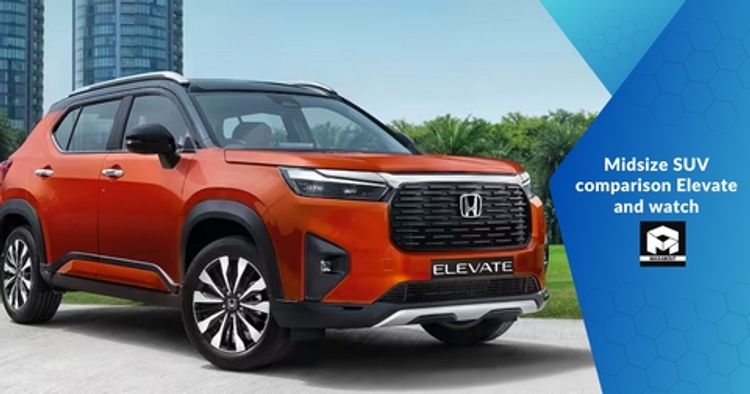Choosing the perfect mid size SUV has never been simple, and now that the powerful Honda Elevate has entered the market, the choice is much harder. We have compared the Elevate side by side with its closest rivals in a market where there are already a ton of options for you to choose from.
The Maruti Suzuki Grand Vitara, which also stands in for its Toyota equivalent, the Urban Cruiser Hyryder, comes first on the list. They are both deserving competitors because of their distinct qualities and styles. The updated Kia Seltos, which showcases the most recent innovations in the SUV class, comes next. The Volkswagen Group's Taigun, pictured here representing its sibling, the Skoda Kushaq, is adding to the mix. These products promise to provide a distinct taste to the SUV competition through the incorporation of German engineering and design.
Finally, but no less, we have Hyundai's Creta, the current leader of this particular sector. The Creta is a hard act to follow because of its features and reputation for sturdiness. In order to assist you in navigating a variety of options, this comparison attempts to analyse the advantages and disadvantages of each SUV. We've got you covered whether you're drawn to the German accuracy of the Taigun, the steady performance of the Creta, the current improvements of the Seltos, the possibilities of the Elevate, or the Vitara's the representation of Toyota's exquisite food.
Features of the Midsize SUVs
1. Unfortunate Absences
Regrettably, MG was unable to provide an Astor for our photo session. Although we were excited to feature the new Citroën C3 Aircross, its absence in the petrol-automatic variant—our ideal configuration for this comparison—could not be ignored.
2. Extensive Criteria Assessment
We will use a broad range of evaluation factors to identify the model that provides the best value in this highly competitive marketplace.
3. Exterior Design Comparison: Conformance to the SUV Template
Every SUV follows the standard SUV design, featuring upright stances, high-set bonnets, and different forms. Their aesthetic choices, however, are very different.
4. Honda Ascent
Even while it's not as showy as some of its rivals, the Elevate stands out thanks to its strong bonnet, bold grille, and detailed surfacing. It stands out thanks to its strong stance and industry-best 220mm ground clearance.
5. Suzuki Grand Vitara Maruti
With its unique two-part grille and split headlight design, the Grand Vitara comes with a refined SUV appearance that makes a statement without being overly conspicuous.
6. Toyota Tiguan by Volkswagen
The Taigun's design is reminiscent of vintage Volkswagen, with its crisp features and simple lines. Its chrome accents give it a hint of classic style. It may, however, appear somewhat smaller in the presence of competitors since it is the shortest and narrowest of the five.
Space and The field of p
Honda Ascent
With a capacious 458-litre boot, the Elevate is the biggest vehicle in this comparison, making it more useful for a range of purposes.
Follow along as we explore the interior, capabilities, and general offerings of these midsize SUVs in further detail, helping you make the best decision in this competitive marketplace.
Mahindra XUV400 vs. Tata Nexon EV: Interior and Seating
On the inside
The Nexon EV's two enormous screens, flat-bottomed steering wheel, and simpler dashboard design all wow factors. enhanced textures and materials for a more premium vibe.
XUV400
The fit and finish are marginally better, and some of the materials feel nicer, but the dashboard design is crowded and antiquated.
Place of Seating
Nexon EV
Best suited for two passengers, rear seats are more comfortable. curved seat with no charging port or AC vents for two people.
XUV400
Less supportive below the thighs, less curved seats. More room in the back for three people, but no charging station or cooling vents.
Features of Mahindra XUV400 vs. Tata Nexon EV
Comprehensive list of features for the Nexon EV includes full LED lighting, ventilated front seats, a 12.3-inch touchscreen, a 10.25-inch digital instrument cluster, a 360-degree camera, front parking sensors, mechanical climate control, wireless charging for smartphones, an electronic parking brake, and a JBL audio system.
Updated features such auto-dimming mirror, ESP, hill-hold assist, cruise control, fog lamps, and tire pressure loss indication are available on the XUV400. Auto lights and wipers, a sunroof, cruise control, 16-inch alloy wheels, leatherette seats, connected automotive technology, and six airbags are included as standard.
Mahindra XUV400 vs. Tata Nexon EV: Performance and Powertrain
New motor for Nexon EV
145 hp and 215 Nm; better efficiency and driveability. 9.3 seconds for 0-100 kph.
XUV400
Quicker speed in 9 seconds, 150 horsepower, and 310 Nm. Performance is impacted by three drive modes and ESP-controlled launch. stronger brakes. comparable capacities of batteries.
Tata Mahindra XUV400 vs. Nexon EV: Ride and Handling
Better highway performance, quicker steering, more grounded at higher speeds, and a firmer suspension define the Nexon EV.
XUV400
Light steering for city driving, bouncy on the highway, detached sense when cornering, smooth low speed ride.
Cost and Decision: Tata Nexon EV vs. Mahindra XUV400
With enhancements and more options, the Nexon EV, which is priced between Rs 14.74 lakh and Rs 19.94 lakh, justifies its premium over the XUV. The price range for the XUV400 is Rs 15.99 lakh to Rs 19.39 lakh. Better in certain aspects, but it feels and looks dated.
With significant improvements in performance, driveability, features, design, and quality, Nexon EV continues to be the industry leader. Although it lacks the overall modern style, the XUV400 has strengths.

